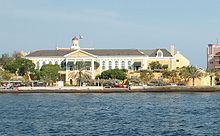Johannes van Walbeeck
Jan, Johan or Johannes van Walbeeck (1602 in Amsterdam – after 1649) was a Dutch navigator and cartographer during a 1620s circumnavigation of the earth, an admiral of the Dutch West India Company, and the first governor of the Netherlands Antilles.
Early life
Van Walbeeck is thought to have been born in Amsterdam in 1601 or 1602 [1][2] and he might be the Jan van Walbeeck, son of the merchant Jacob van Walbeeck and of Weijntgen van Foreest, who were apparently the only Walbeeck family in town, and was baptized on 15 August 1602 in Amsterdam.[3]
He studied at the
In 1627, Van Walbeeck continued his mathematics and physics study in Leiden, but interrupted it again to join Laurens Reael's diplomatic mission to Denmark at the end of the year. Upon his return, he enlisted in a fleet that sailed to the Dutch East Indies.[1]

Dutch West India Company
In 1629, back in the Netherlands, he changed employment from the

In 1633, Van Walbeeck and the governor of Dutch Brazil,
Governor of the Netherlands Antilles.
On 6 April 1634 Van Walbeeck was assigned with the task of taking St Anna Bay on
In 1638, he and Le Grand were sent to Brazil, while
Like
Bibliography
- Johannes van Walbeeck (attributed), Journael vande Nassausche vloot, ofte Beschryvingh vande voyagie om den gantschen aerdt-kloot, gedaen met elf Schepen, onder `t Beleydt van den Admirael Iaques L`Heremite, ende Vice-Admirael Gheen Huygen Schapenham, in de Jaren 1623, 1624, 1625 en 1626, Amsterdam 1626
References
- ^ a b c d e "Encyclopedie van de Nederlandse Antillen" (in Dutch). Curacao-encyclopedia.com. Archived from the original on 2014-04-19. Retrieved 2014-05-14.
- ^ Donkersloot-de Vrij, M. (2003). "Repertory of Dutch mapmakers" (PDF). Maphist.nl. p. 215.
- ^ "Doopregisters voor 1811" (in Dutch). Stadsarchief.amsterdam.nl. Archived from the original on 2014-10-15. Retrieved 2014-05-14.
- ^ "Nassau Index". 2007-06-21. Archived from the original on June 21, 2007. Retrieved 2014-05-14.
- ISBN 0-521-39268-3
- ^ ISBN 1-57607-027-1.
- ^ "De geschiedenis van de Nederlandse Antillen". Engelfriet.net. Retrieved 2014-05-14.
- ISBN 0-670-68628-X
- ^ "Begraafregisters voor 1811" (in Dutch). Stadsarchief.amsterdam.nl. Archived from the original on 2012-05-30. Retrieved 2014-05-14.
Further reading
- Eisler, William Lawrence and Bernard Smith, ed. Terra Australis: The Furthest Shore. Sydney: International Cultural Corporation of Australia, 1988.
- Goslinga, Cornelis Christiaan. A Short History of the Netherlands Antilles and Surinam. The Hague: Martinus Nijhoff, 1979.
- Hartog, Johannes. History of the Netherlands Antilles. Aruba: DeWitt, 1968.
- Henige, David P. Colonial Governors from the Fifteenth Century to the Present. Madison: University of Wisconsin Press, 1970.
- Hoebel, Edward Adamson, ed. The Netherlands East and West Indies. Inter-Allied Publications, 1945.
- Klooster, Wim. Illicit Riches: Dutch Trade in the Caribbean, 1648–1795. Leiden: KITLV Press, 1998.
